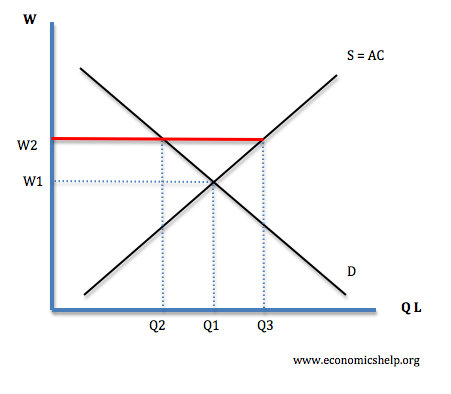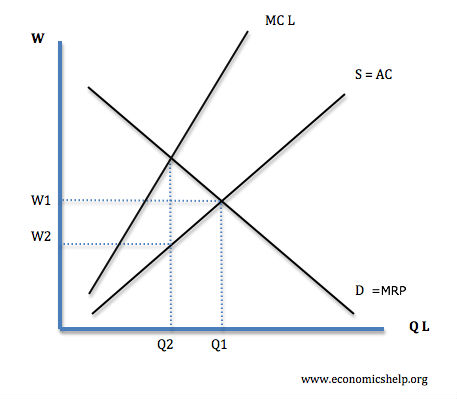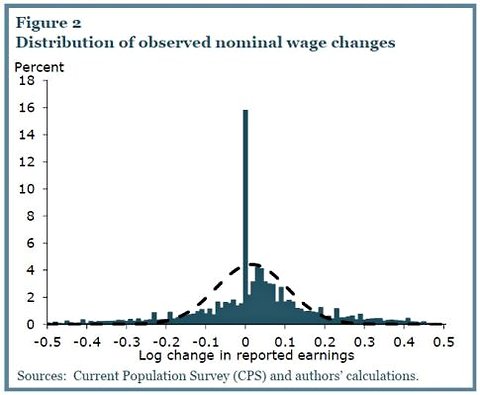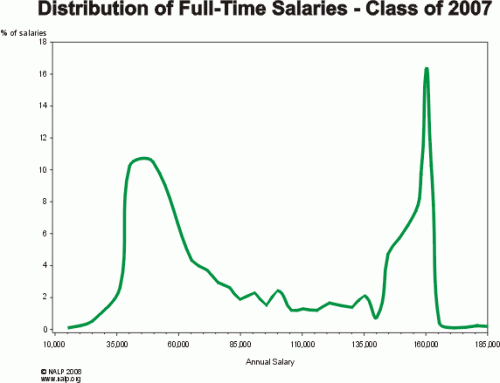Readers Question: How much bargaining power do workers have?
Bargaining Power is the ability for firms or workers to get what they want. An example of bargaining power is related to the power of trades unions.
- If a part-time worker works for a firm with monopsony power, they will have very low bargaining power.
- However, if workers join a trade union and achieve 100% density (i.e. everyone in the firm joins) then they have the capacity to influence the wage making process.
Classical economic theory assumes wages will be determined by free markets and the interaction of supply and demand. This theory assumes workers are wage takers. However, if workers are organised into trades unions, they can have significant bargaining power in pushing wages above the equilibrium.
Example of trades unions pushing wages above equilibrium:

Also, another scenario in the real world occurs when firms often have a degree of monopsony power which enables them to set low wages and pay workers substantially less than the competitive wage.

Monopsonies can pay a wage of W2.
Firms can gain monopsony power because:
- There is only one main employer in a particular region/industry. Workers have no choice who to work for.
- Workers lack information about other jobs.
- Significant costs and difficulties in workers moving between companies. E.g. firms may distrust workers who frequently move to look for a higher wage; geographical immobilities in moving.
- The wage rate is only one factor out of many that motivate workers. A worker may stay in a job where he feels a certain degree of certainty rather than move to another company with a higher wage.
- High rates of unemployment give firms greater choice in choosing workers.
Factors which increase Bargaining power for workers
- Unique skills and qualifications. A worker with more unique skills will have a greater impact on wage determination. A professional footballer can command a high wage because his ability can make a huge difference to the earning power of the club. In football clubs, the wage bill often becomes the biggest cost for a club – because skilled labour is everything.
- Trades Unions. A well organised union can bargain for higher wages. This is especially true when they have some leverage, such as the threat of strikes or go-slows.
- Union density. If everyone at work is in the union, then strike action poses a greater threat.
- Profitable Firm. If a firm is profitable, workers know the firm can afford to pay higher wages.
- Importance of labour to the firm. In some firms, labour is the most important factor of production. E.g. in a legal firm, the ability of lawyers will make a big difference to the success of a firm. In some manufacturing firms, improved technology may mean labour becomes a much smaller share of costs.
- If they are producing a key good. Print unions used to have a lot of power because they could stop daily newspapers from being printed. Coal miners and railway workers were also key workers with more bargaining power. If you work in the leisure industry, workers are less indispensable.
Who has more bargaining power firms or workers?
Apart from rare cases of real union power, I would say generally firms have more bargaining power in setting wages. In all the jobs I’ve worked at, I have never been involved in determining wages. The firm set wages and conditions, and you accept it or not. I think for the majority of workers, it is like this. True, workers can move to other jobs, but there are real costs and difficulties in switching jobs.
However, most firms are conscious of the need to attract good workers, so wages can often be pushed up by market forces.
Clearly this process depends on the type of job. With skilled jobs creating a greater incentive to push up wages.
Wages Sticky Downwards
Another factor is that workers may struggle to increase wages, but they have more success in preventing wage cuts. For example, since the credit crunch, wages have not fallen – despite a rise in unemployment. There is considerable evidence that wages are sticky downwards. This may be due to the fact firms are reluctant to cut nominal wages because of the adverse impact on labour productivity.

nominal wage rigidity in US – The most common wage change is 0%
Wage Rigidity in US Lawyers

The distribution of salaries for lawyers in US is biased around two peaks at $40,000 and $160,000. That $160,000 salary has stayed constant since 2007 – suggesting there is significant wage rigidity in lawyer fees.
Since 2007, the starting wage has remained at $160,000 but less jobs are available at this wage rate.
Law firms have kept this high wage because
- They don’t want to lose face by paying less than $160,000 – they don’t want to appear they are no longer top tier.
- Don’t want to miss out on best talent – though there is substantial excess supply. Plenty of newly hired grads didn’t get a job.
- This rigidity is not so much bargaining power of new lawyers (many would probably be willing to work for less) but reflects rigidities in wages.
See more on Econ Mix – top tier lawyers (NY Times, subscription required)
Why two contrasting peaks?
- The $160,000 salaries are for lawyers working in big blue-chip companies
- The $40,000 salaries are for lawyers working for the government or small companies.
Related
